| |
Sunday, June 15, 2008, 3:45 PM GeneralPosted by matthew By now, you may have heard of the big earthquake that hit northern Japan yesterday morning. At 7.2 on the Richter scale, it ranks as a "major" earthquake. In our part of Kitakami, it reached 5-upper on the shindo scale, intense enough to cause cracks in the walls of earthquake-resistant structures. But at our house, it just spilled some coffee, knocked a few books off shelves, and caused the automatic safety device to cut off our gas. Of course, it was big enough to cause us worry. Perhaps the strangest thing about it was how it went on, and on, and on. I guess every big earthquake feels like it goes on forever to the people experiencing it, but this one really did go on for almost 20 minutes. Well, the intense shaking did, anyway; I guess it was probably actually several earthquakes in quick succession, but the vibrations from each were still going when the next arrived. Here are the earthquake maps from the Japan Meteorological Agency showing the earthquake at 8:47, and still going strong at 9:01. 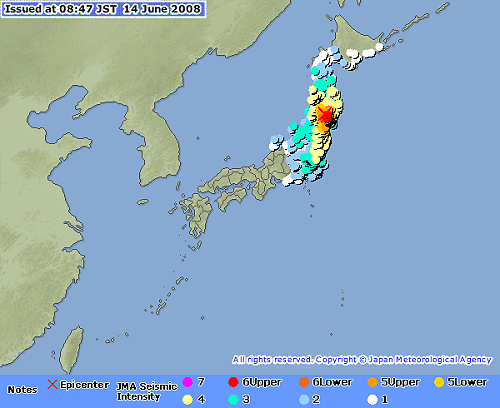 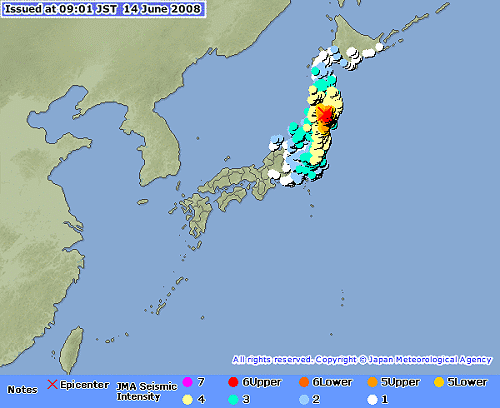 Just how close was this to us? Here's a zoomed view. 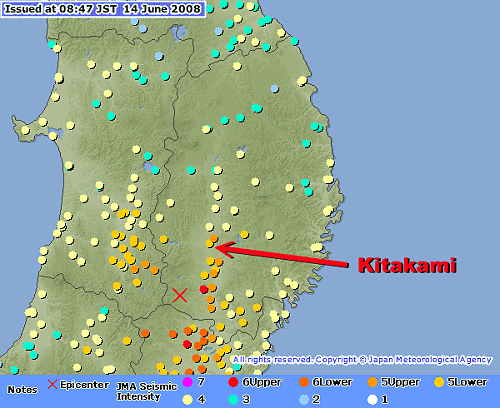 And just how (not) bad was it for us? Well, here's the shelf that moved. Some games almost fell, and a few books did fall. 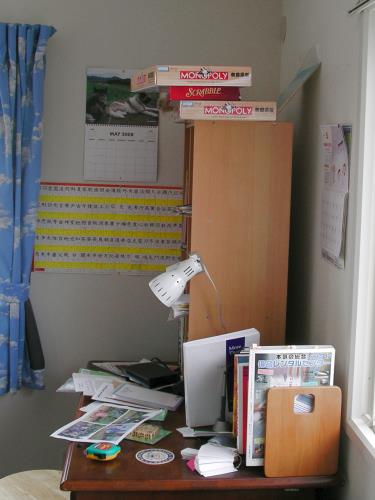 Shortly after 9, the intensity fell off. But — and this was a very strange sensation — the ground continued to gently roll and pitch for about another hour. As it continued, we picked ourselves up, checked for damage, reset the gas supply, and started to go back about our business. By the time it stopped, we were so used to it that we were still unsteady on our feet, like when you step on dry land after spending some time in a small boat. The rest of the day and night were a continuous series of aftershocks, sometimes just minutes apart. By 10pm, just 13 hours after the earthquake, there had been nearly 200 aftershocks. Many more came throughout the night, and they have been continuing today with less frequency.
On my way back to the office last week, I had an unusual cabbie. For one thing, he was chatty, unlike the other Japanese cabbies I've encountered. For another, he looked very much like one of my bosses back in Washington, if my boss had been Japanese rather than of Mediterranean descent. It was the second time he'd been my driver, and both times I noticed the resemblance immediately. Occasionally, we come across Japanese versions of familiar faces from back home. What's interesting about these occurrences is that they cover a wide variety of Western features. My boss looks nothing like an old client, American Idol-era Clay Aiken, or Steven Spielberg, yet we've seen Japanese versions of each of them. And, as a general rule, Japanese features are pretty homogeneous, so it's not like we're keying off of similarities in hair or eye color. It would be easy to say it's a trick of the mind, that it comes from needing some connection to home, but the first J-Clay sighting occurred while we still lived in America. The likenesses must come from somewhere more fundamental than that. Anthropologists and ethnologists probably have researched this phenomenon and come to some conclusions about why we see the familiar in the apparently unrelated. For us, the non-scientists, it's just a part of the ongoing adventure — who are we going to see next?
Hachimantai is a mountain and national park that straddles the border between Iwate and Akita. It's also the scene of the "Aspite Line", a very scenic drive that crosses the mountain near its summit. Even in May, there was plenty of snow near the top. 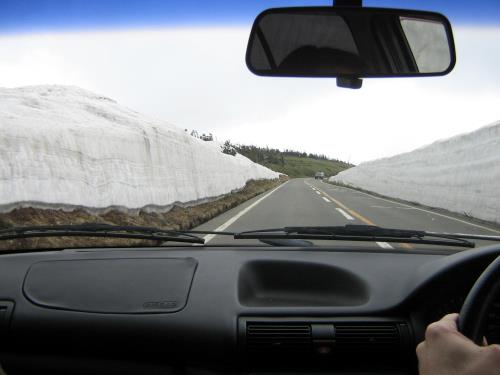 On the Iwate side, there are alleged to be some spectacular views. All we saw was fog, though.  And here's the view when we finally got our oscillation overthruster working. 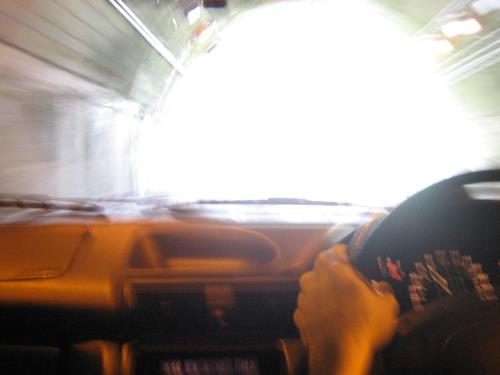 (Photos by Robert Davis. Hi, Dad!)
Dancing the Bad Luck Away
Earlier this month, we attended Jinku Matsuri in Esashi, a small town south of Kitakami. Jinku Matsuri is a festival featuring dances performed by people from Esashi who are celebrating their 25th or 42nd birthdays. 25 and 42 are traditionally yakudoshi years for men, but both men and women performed in the dance groups or in their accompanying music groups. Prior to the featured dances, local children danced in a parade that passed through the main festival ground. 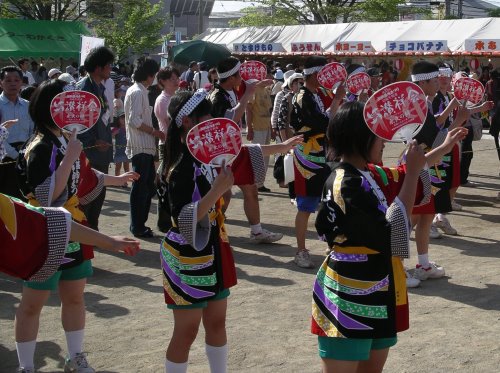 The 25-year-olds made a big impression with their wicked hairstyles, and later with their original music and dance. The amount of energy they created in the festival ground was amazing. 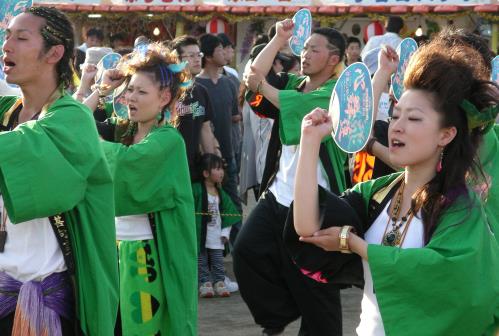 The excitement was amplified by the 42-year-olds' entry. Seriously ¡½ the 25-year-olds' musicians played with a lot of drive, but when the 42-year-olds took over the parade song, they did so with a huge BOOM! of drums and more complex movements. It was wild. 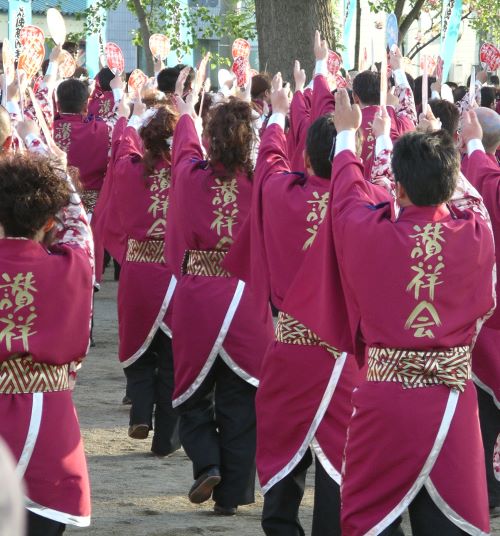 They also provided a flash of style during their original dance. 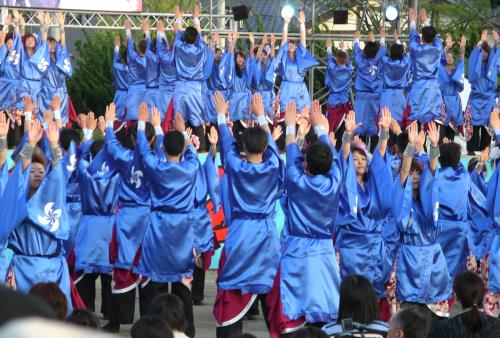
Having visitors is the perfect prod to do all the things you've wanted to do, but haven't. Like going to the Iwate coast — it's so close, and yet we'd never been. So on a beautiful Tuesday morning, we prepared for a day trip to the coast, stopping at Hige-oyaji's place for breakfast. We told him our plans; he got really excited and animatedly told us to go to the Goishi Kaigan to see Kaminari-iwa, "Thunder Rock." Kaminari-iwa is a longish outcropping of rock running parallel to a cliff. Ocean water charges through the gap between them, creating a huge "BOOM!" as it does, hence the name. Because he's awesome, Hige-oyaji hooked us up with an outfit running small speedboat cruises around the sights in that area, including through the Kaminari-iwa gap. From the shore, Kaminari-iwa looks very cool, and the movement of the water through the gap is mesmerizing. 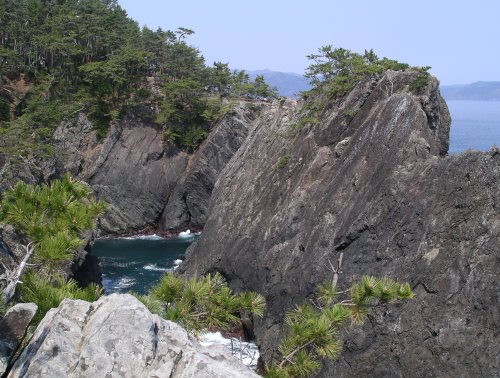 You get way more of the "thunder rock" effect from land than on the ocean. The turnaround part of the boat trip took us through Anatoshiiso, a rock formation rather resembling a giant, rocky set of brass knuckles. On the initial approach, it was not at all clear to us that our speedboat was going to fit through that middle hole. 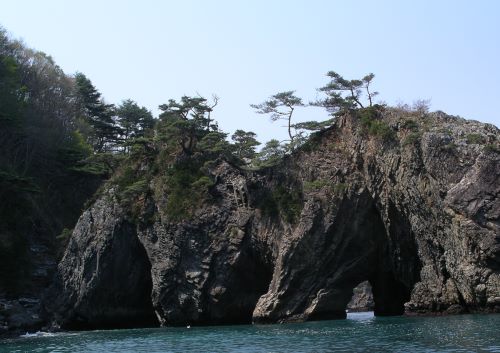 It did, thanks to the careful maneuvering of the boat pilot.
One of the main reasons our houseguests chose to visit us in the spring was the sakura ¡½ o-hanami, or flower-viewing, is a big deal in Japan. The Japan Meteorological Association publishes "sakura forecasts" throughout the spring so that people can plan their o-hanami trips accordingly. Additionally, some organizations have ranked the "best sakura-viewing locations" throughout Japan; JR features Tenshochi on its posters as one of the three best places in northern Tohoku. O-hanami is about more than just looking at the flowers. Restaurants, civic groups, or just groups of friends plan picnics with lots of food and drink in prime blossom-viewing locations. This year, the blossoms came about two weeks early, so by the time our houseguests arrived, the sakura were mostly gone from Kitakami. Nevertheless, we joined the local Okinawan joint's o-hanami party in one of the last parks to have blossoms. The day itself was not optimal for picnicking under the remaining sakura, being all cold and gray. So we made plans to go to Fukusenji, a temple in nearby Tono, with some friends the following day. At Fukusenji, we found the trees in full bloom. So did busloads of tourists from other parts of Japan. 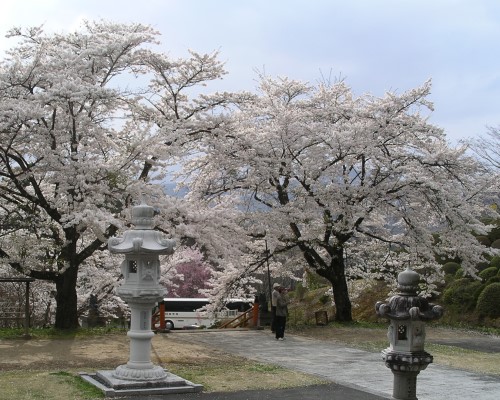 Many other trees were coming to life at the same time. On a small overlook, sakura and leafing yamamomiji (mountain maple) trees shared the view. 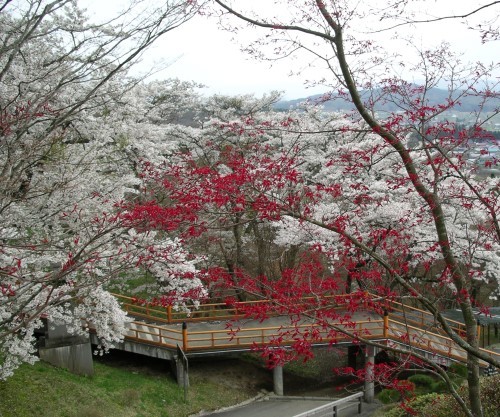
[ 2 comments ] permalink
The Great Butter Shortage of '08
Saturday, May 17, 2008, 1:19 AM General, FoodPosted by stefanie Rice shortages have been in the news over the last month or so as rice-exporting countries have begun withholding supplies to feed their own people. The shortages don't appear to be affecting Japan, but the country is running low on something important: butter. For the last three weeks or so, finding butter in the stores has been hit or miss, but mostly miss. The stores kindly post signs apologizing for the lack of butter, which is cold comfort when you're contemplating dry toast for breakfast. Japan isn't generally perceived as being a dairy-centric country, so the butter deficit seems kind of surprising. To be sure, there are Japanese dairies and the Japanese do eat things like yogurt, cheese, and, ice cream. But dairy products aren't a staple in the Japanese diet like they are in the American diet, even as bread (and consequently butter) consumption has increased. None of the other dairy products appear to be in low supply (although I did notice a dearth of imported cheese today), either. Just butter. I did find a decent supply of butter in the second store I visited today, but refrained from frantically purchasing all of it.
[ 3 comments ] permalink
Wednesday, May 7, 2008, 2:27 AM GeneralPosted by stefanie Sorry for the lack of new postings over the past week; we've been busy with houseguests. We're going on a road trip tomorrow, so we'll be offline for about a week. See you when we get back!
[ 3 comments ] permalink
If the Shoe Fits, Make Sure It's Easy to Get Out Of, Too
Even though I've lived here for almost a year, I'm still dealing with my stash of completely impractical shoes on a daily basis.
You see, while my Doc Martens combat boots, open-toed strappy sandals with three-inch heels, and knee-high zip-up boots are perfectly fine for an American life, they're not so great in Japan. Living here means taking your shoes off whenever you enter your house, someone else's house, and many restaurants. Most Japanese wear simple slip-on shoes or low shoes like oxfords that can be tied loosely enough to slip off and then on again with the aid of a shoehorn (everyone has a shoehorn). Mules and ballet flats are popular choices for women. They're often worn with very short socks so that when you take them off, you're not walking around in your bare feet or sticking them in community slippers.
I, on the other hand, am usually the last one into or out of the house or restaurant because I need to unzip or untie my boots. "I'll catch up" is my new mantra. The three-inch heels are generally fine, but being open toed, they don't really lend themselves to even tiny socks (although that doesn't seem to stop the Japanese). After an ego-destroying trip to try buying pants, I haven't tried to purchase any kind of clothing in Japan, so I'm still working with what I brought, practicality be damned. Also, I love my shoes, so they're staying.
[ 2 comments ] permalink
Wednesday, April 9, 2008, 2:52 AM GeneralPosted by stefanie There comes a time in many expatriates' lives when they have to trade a significant privilege in their home country for the same privilege in another. It's a privilege borne of study, practice, near-misses, frayed nerves, and hours upon hours spent standing in line in a soul-sucking fortress, listening to Phil Collins on endless loop, waiting your turn for someone to be mean to you. Repeatedly. I'm talking about drivers' licenses, of course, and our time has come.
We went to the main driving center in Morioka yesterday to start the process of changing our U.S. licenses over to Japanese ones. We'd heard that they'd turn us away if we didn't have a translator with us, but Matthew had been so successful in scheduling our appointment in Japanese that we decided to risk it and go ourselves. Expecting a standard-issue MVA/DMV experience, we took lots of reading material and braced ourselves.
We actually got to the driving center early, so we were really prepared to wait. Instead, the guy Matthew had spoken to earlier came to get him about five minutes after we checked in. We had separate interviews, which made me nervous because of my weaker language skills. To my relief, the interviewer was very kind and patient, even though he called me by my middle name the whole time: Kay-san (more accurately, Kei-san).
He apparently felt that our driving experience was good enough to take the written and driving tests, so he set us up with the paperwork for those. After all of that was done, he took us out to the photo machine to get the necessary pictures. The voice on the machine encouraged us to "relax" ourselves for the photo. "Ready? Here we go! 3, 2,1 *click* Thank you! Please wait for your photo to print." Seriously ¡½ the photo machine was nicer than any DMV employee I've ever encountered.
Total time? An hour and a half. We still have to take and pass the tests to get our licenses, but we're on our way, and have nothing but warm fuzzies for the Iwate driving center people.
[ 4 comments ] permalink
Back Next
|
|



















 Calendar
Calendar




